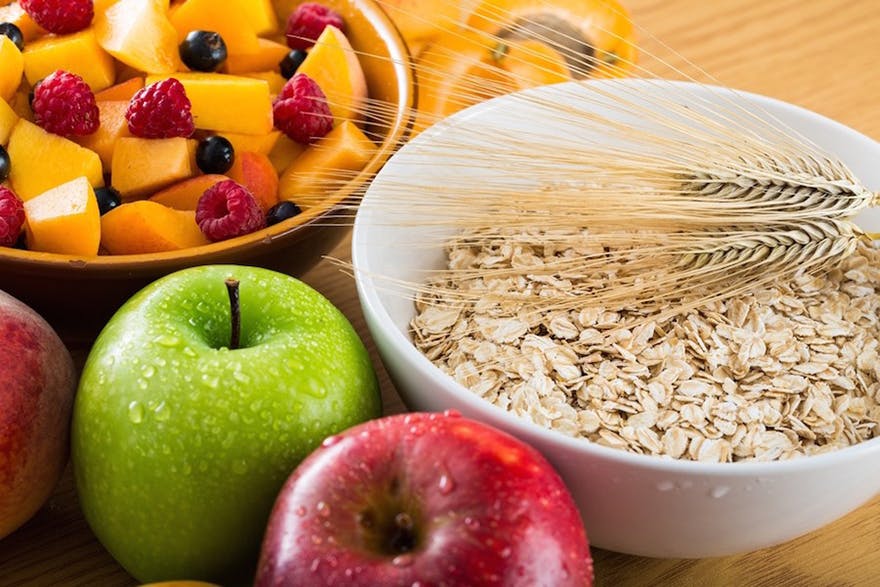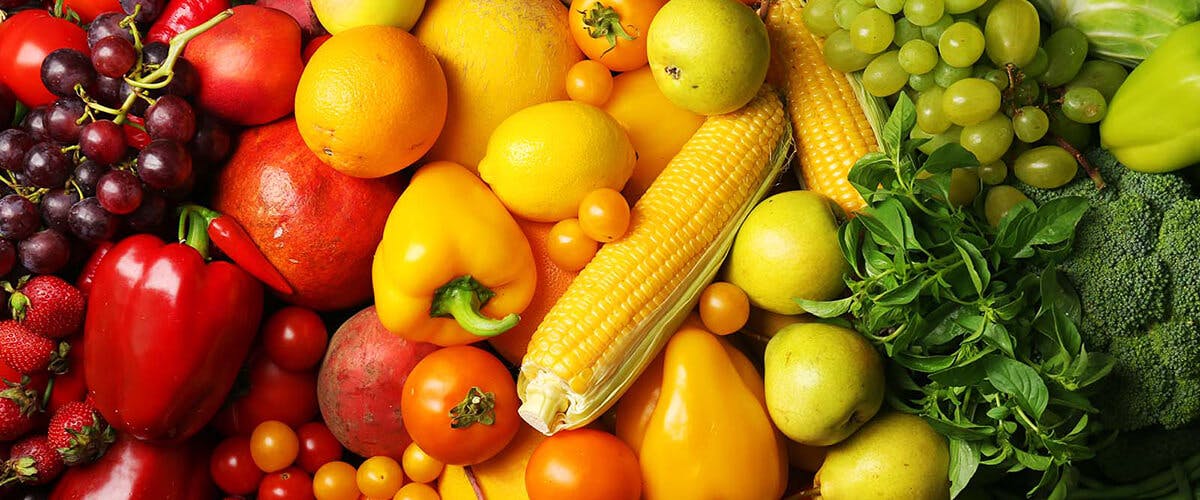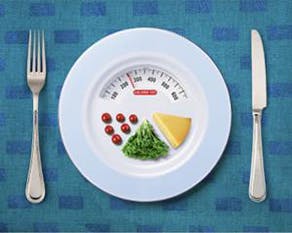Dietary fiber: Essential for a healthy diet
HEALTH & WELLNESS
10.21.2014

Eat more fiber. You've probably heard it before. But do you know why fiber is so good for your health?
Dietary fiber — found mainly in fruits, vegetables, whole grains and legumes — is probably best known for its ability to prevent or relieve constipation. But foods containing fiber can provide other health benefits as well, such as helping to maintain a healthy weight and lowering your risk of diabetes and heart disease.
Selecting tasty foods that provide fiber isn't difficult. Find out how much dietary fiber you need, the foods that contain it, and how to add them to meals and snacks.
What is dietary fiber?
Dietary fiber, also known as roughage or bulk, includes all parts of plant foods that your body can't digest or absorb. Unlike other food components, such as fats, proteins or carbohydrates — which your body breaks down and absorbs — fiber isn't digested by your body. Instead, it passes relatively intact through your stomach, small intestine, colon and out of your body.
Fiber is commonly classified as soluble (it dissolves in water) or insoluble (it doesn't dissolve):
- Soluble fiber. This type of fiber dissolves in water to form a gel-like material. It can help lower blood cholesterol and glucose levels. Soluble fiber is found in oats, peas, beans, apples, citrus fruits, carrots, barley and psyllium.
- Insoluble fiber. This type of fiber promotes the movement of material through your digestive system and increases stool bulk, so it can be of benefit to those who struggle with constipation or irregular stools. Whole-wheat flour, wheat bran, nuts, beans and vegetables, such as cauliflower, green beans and potatoes, are good sources of insoluble fiber.
Most plant-based foods, such as oatmeal and beans, contain both soluble and insoluble fiber. However, the amount of each type varies in different plant foods. To receive the greatest health benefit, eat a wide variety of high-fiber foods.
Benefits of a high-fiber diet
A high-fiber diet has many benefits, which include:
- Normalizes bowel movements. Dietary fiber increases the weight and size of your stool and softens it. A bulky stool is easier to pass, decreasing your chance of constipation. If you have loose, watery stools, fiber may also help to solidify the stool because it absorbs water and adds bulk to stool.
- Helps maintain bowel health. A high-fiber diet may lower your risk of developing hemorrhoids and small pouches in your colon (diverticular disease). Some fiber is fermented in the colon. Researchers are looking at how this may play a role in preventing diseases of the colon.
- Lowers cholesterol levels. Soluble fiber found in beans, oats, flaxseed and oat bran may help lower total blood cholesterol levels by lowering low-density lipoprotein, or "bad," cholesterol levels. Studies also have shown that fiber may have other heart-health benefits, such as reducing blood pressure and inflammation.
- Helps control blood sugar levels. In people with diabetes, fiber — particularly soluble fiber — can slow the absorption of sugar and help improve blood sugar levels. A healthy diet that includes insoluble fiber may also reduce the risk of developing type 2 diabetes.
- Aids in achieving healthy weight. High-fiber foods generally require more chewing time, which gives your body time to register when you're no longer hungry, so you're less likely to overeat. Also, a high-fiber diet tends to make a meal feel larger and linger longer, so you stay full for a greater amount of time. And high-fiber diets also tend to be less "energy dense," which means they have fewer calories for the same volume of food.
Another benefit attributed to dietary fiber is prevention of colorectal cancer. However, the evidence that fiber reduces colorectal cancer is mixed.
How much fiber do you need?
How much fiber do you need each day? The Institute of Medicine, which provides science-based advice on matters of medicine and health, gives the following daily recommendations for adults:
| Age 50 or younger | Age 51 or older | |
|---|---|---|
| Men | 38 grams | 30 grams |
| Women | 25 grams | 21 grams |
Institute of Medicine, 2012
Your best fiber choices
If you aren't getting enough fiber each day, you may need to boost your intake. Good choices include:
- Whole-grain products
- Fruits
- Vegetables
- Beans, peas and other legumes
- Nuts and seeds
Refined or processed foods — such as canned fruits and vegetables, pulp-free juices, white breads and pastas, and non-whole-grain cereals — are lower in fiber. The grain-refining process removes the outer coat (bran) from the grain, which lowers its fiber content. Similarly, removing the skin from fruits and vegetables decreases their fiber content.
Fiber supplements and fortified foods
Whole foods rather than fiber supplements are generally better. Fiber supplements — such as Metamucil, Citrucel and FiberCon — don't provide the variety of fibers, vitamins, minerals and other beneficial nutrients that foods do.
However, some people may still need a fiber supplement if dietary changes aren't sufficient or if they have certain medical conditions, such as constipation, diarrhea or irritable bowel syndrome. Always check with your doctor if you feel you need to take fiber supplements.
Fiber is also added to some foods. However, it's not yet clear if added fiber provides the same health benefits as naturally occurring sources.
Tips for fitting in fiber
Need ideas for adding more fiber to your meals and snacks? Try these suggestions:
- Jump-start your day. For breakfast choose a high-fiber breakfast cereal — 5 or more grams of fiber a serving. Opt for cereals with "whole grain," "bran" or "fiber" in the name. Or add a few tablespoons of unprocessed wheat bran to your favorite cereal.
- Switch to whole grains. Consume at least half of all grains as whole grains. Look for breads that list whole wheat, whole-wheat flour or another whole grain as the first ingredient on the label. Look for a brand with at least 2 grams of dietary fiber a serving. Experiment with brown rice, wild rice, barley, whole-wheat pasta and bulgur.
- Bulk up your baked goods. Substitute whole-grain flour for half or all of the white flour when baking. Whole-grain flour is heavier than white flour. In yeast breads, use a bit more yeast or let the dough rise longer. When using baking powder, increase it by 1 teaspoon for every 3 cups of whole-grain flour. Try adding crushed bran cereal, unprocessed wheat bran or uncooked oatmeal to muffins, cakes and cookies.
- Mix it up. Add pre-cut fresh or frozen vegetables to soups and sauces. For example, mix chopped frozen broccoli into prepared spaghetti sauce or toss fresh baby carrots into stews.
- Get a leg up with legumes. Beans, peas and lentils are excellent sources of fiber. Add kidney beans to canned soup or a green salad. Or make nachos with refried black beans, lots of fresh veggies, whole-wheat tortilla chips and salsa.
- Eat fruit at every meal. Apples, bananas, oranges, pears and berries are good sources of fiber.
- Make snacks count. Fresh fruits, raw vegetables, low-fat popcorn and whole-grain crackers are all good choices. An occasional handful of nuts or dried fruits also is a healthy, high-fiber snack — although be aware that nuts and dried fruits are high in calories.
High-fiber foods are good for your health. But adding too much fiber too quickly can promote intestinal gas, abdominal bloating and cramping. Increase fiber in your diet gradually over a period of a few weeks. This allows the natural bacteria in your digestive system to adjust to the change.
Also, drink plenty of water. Fiber works best when it absorbs water, making your stool soft and bulky.
Image Credits: Billion Photos/Shutterstock.com
Recommended Articles
The 5 Best Foods That Will Help Supercharge Your Brain
Amidst our busy schedule, it's important to retain our focus and memory. Resting alone is not...
Iron deficiency is a lot more common than you would think. A recent survey by SATA CommHealth(i...
Mars vs Venus: Understanding the His and Hers of Nutritional Needs
Mars vs Venus: Understanding the His and Hers of Nutritional Gaps Although their DNAs are...






